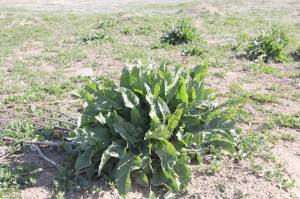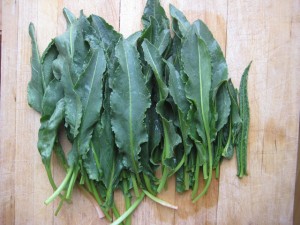
Curly dock is invasive in North America, South America, New Zealand, and Australia.
by Erica Marciniec, www.wildfoodgirl.com
Stare out across the empty lots and fields on the outskirts of Denver, Colorado, and you will see scattered clumps of dark green leaves towering above the grass. In spring the not-yet-flowering offspring of older plants are in rosette form, while others emerge from the base of last year’s dried flower stalks. Later in the season, mature plants can send up multiple stalks, becoming even bushier and more apparent than they were as rosettes.
The plant is curly dock, a rhubarb relative in the buckwheat family known alternately as sour or yellow dock. The “curly” moniker comes from the wavy or crisped margins that often characterize the leaves and “sour” speaks to their pleasing, lemony flavor.
Bad Farm Forage, Good Folk Food
Curly dock is good forage for humans, though such is not the case for livestock. Many is he in farm country who has spent days clearing pastures of the stuff, for, as USU Extension explains, the leaves of curly dock “are poisonous to cattle and sheep; the “seeds and vegetation of curly dock are toxic to poultry and can cause dermatitis and gastric problems in cattle;” and curly dock is “an alternate host to many crop diseases.” It is also indicted for toxicity to horses.
The nonnative plant is found in agricultural landscapes throughout the U.S. and listed as invasive in 15 states, though author Samuel Thayer suspects that it is only marginally so, since “it does not tend to invade natural habitats” like more harmful nonnatives such as garlic mustard and kudzu.
Still, if you must pull it out of your pasture so the cows don’t get sick, why not eat curly dock while you’re at it?
Among its nutritional components, John Kallas (2010) explains, “Curly dock leaves are high in beta-carotene, vitamin C, and zinc” and the seeds are “rich in calcium and fiber while low in protein and fat.”
As long as it is collected from a location free of herbicides, excessive car exhaust, or other pollutants, it is free, organic green fare. As Steve Brill (1994) points out, curly dock “became an important vegetable during the Great Depression, when people were hungry.”
Last but not least, curly dock is yummy, lauded as “an abundant delicacy that widely passes for a weed” by Kathryn G. and Andrew L. March (1979). I personally make use of it and other Rumex relatives throughout their growing seasons, including blanching or sautéing and freezing batches to last through winter.
Native Species Are Not Invasive
There are many edible docks in the Rumex genus, some native and some introduced. Curly dock (R. crispus), patience dock (R. patientia), bitter dock (R. obtusifolius), and domestic dock (R. domesticus) are introduced species, whereas willow dock (R. triangulivalvis / R. salicifolius) and Western dock (R. occidentalis) are native. Rumex species can be difficult to tell apart by leaf shape alone, though the fruits can be used to distinguish between them (Thayer, personal communication, 2012). Flavors vary among species, with several authors reporting a preference for curly dock.
Plants are perhaps easiest to locate by the presence of the previous year’s rusty brown stalks and fruits, from the base of which emerge young, edible leaves in spring. Curly dock’s basal rosette leaves are “elongated lanceolate or nearly linear,” and “rounded or tapered at the base” (Thayer, 2010), ranging in shape from broad to less so (Kallas, 2010). “At the base of the petiole there is a papery sheath called the ocrea,” writes Thayer. “It surrounds the stem and holds a bunch of slime when the plants are young but becomes dry, brown, and brittle later on.”
Dock Trials, Errors, and Triumphs
As with any unfamiliar wild plant, a certain amount of trial and error is to be expected. For example, my first dock taste tests came from old, tough specimens collected along a dusty road; they took eons to wash and boil until chewable, and then turned out slimy and repugnant despite all my efforts.
“A well-hydrated plant that has healthy great-looking leaves is more likely to have leaves that cook into greatness,” Kallas (2010) writes, and the point is well taken: Look for plants with healthy leaves—not old, dirty ones riddled with bug holes—just as you do when picking vegetables from a garden.
Thayer (2010) says to get leaves just as they are unfurling or recently unfurled, a point that went a long way toward my success with curly dock. I now take newly emerged leaves while they’re still rolled up, slightly unrolled leaves, and fully unrolled new leaves, leaf stems and midribs and all. New leaves of spring or new leaves growing from midsummer plants are all game—-just as long as they’re young and clean. And slime is a good thing; it means the leaves are fresh and ready to harvest.
Rumex crispus
Native range: Europe and North Africa
Introduced range: All 50 states
Habitat: Common in fields, along roadways, gardens, and yards, and in other disturbed areas. Also found in glades, meadows, and along streams and riverbanks.
Description: Leaves with curled edges and a course texture. From 2 to 4 feet tall, with a stout taproot with a pale yellow interior. Small green flowers bloom in northern summers. Dark brown winged seeds distributed by wind or water, can remain viable in the ground for 50 years.
Recipes
I like to lay curly dock leaves lengthwise on a cutting board and chop into whorled slices, sauté in olive oil and garlic until soft or longer until they’re slightly crispy, and serve as a side dish. I have also added sautéed dock to egg dishes, stuffings, stir fries, cream sauce with pasta, cracker spread with cream cheese, potato soup, bean dishes, saag paneer, and pizza. For cooking ideas from a range of contributors, including recipes for dock seeds, check out the March 2012 recipe share at Hunger and Thirst for Life.
First time dock eaters should of course follow wild food procedure and cross reference multiple guidebooks or seek out expert advice to confirm their identification, then do a lip test (rub it on the lips to see if there’s a reaction) and a personal edibility test (eat a small amount and wait 24 hours) before consuming in greater quantity.
Like spinach, docks contain oxalic acid and therefore should not be overindulged upon in one sitting. A plate of food per meal is probably a reasonable portion, as opposed to eating several pounds at a time. That said, I once served curly dock dinner dishes for five days straight without incident—with the exception that my boyfriend eventually begged for respite from the lemony Rumex.
I always forage curly dock judiciously, selecting only the choicest leaves so as not to stress the plants. If you’re trying to rid a field of it, however, you might as well go ahead and pillage them, grabbing every spring leaf you see and digging up the medicinal root while you’re at it. After all, that is the point of eating an “invader” when it pops up in a less-than-ideal location.
Quotes
April the 18th Both the Swedish and English settlers are in the spring accustomed to prepare greens from various plants of which the following are the most important; Rumex crispus L. is a kind of sorrel which grows at the edge of cultivated fields and elsewhere in rather low land.* Farmers choose a variety which has green leaves instead of pale colored ones. . . . These green leaves are gathered at this time everywhere and used by some people in the same way that Swedes prepare spinach. But they generally boil the leaves in the water in which they had cooked meat. Then they eat it alone or with the meat. . . . Here also vinegar is placed in a special container on the table to be used on the kale. I must confess that this dish tastes very good.
–Peter Kalm, botanist sent by the Swedish Academy to North America in search of hardy seed material, 1749
*Kalm’s description of classic invader habitat, the edge of cultivated fields and low lands, indicates that this was an exotic brought in by the English.
“Rumex crispus L., Curled Rumex. Vulgò––Sour Dock. Curled Dock.
The radical leaves of this are often used as a pot-herb, or early “Greens”; but the plant is an unsightly and troublesome weed,––and has become so extensively naturalized as to require a vigilant attention to keep it in due subjection.”
– William Darlington, Agricultural Botany: an Enumeration and Description of Useful Plants and Weeds Which Merit the Notice, or Require the Attention of American Agriculturists, 1847






























{ 11 comments… read them below or add one }
I heard that the liquid excreted from mashed leaves, is a good remedy for Poison Oak. Does anyone have info, or experience, that might confirm this?
I have been using these in Green Smoothies since 1988. Can’t imagine developing recipes from wild edibles and other way.
Curly dock roots can be made into a flour.First peel the root mash strain to remove fibers dry and
pound to a flour.
Trying to enjoy some young, tender leaves but even they are tough and bitter. I’ve used the seeds in cookies with success but not sure raw leaves will ever appeal. Does cooking reduce the bitterness? Mine do not taste “tart.” Might try sautéing them in a bit of bacon trimmings.
What can one do with the seeds and also I was digging one up and noticed the roots are real fat. Are they edable too? Can one cook them?
I pick the young, tender, leaves of the curly dock and put them in my green smoothies. I also like the leaves cut up into small pieces with a scissors and layered on my bean burritos or stirred into my beans and rice.
Wonderful! I’m trying to eradicate this weed from my acreage (it does tend to take over) and knowing that it is edible will go a long way toward making me feel better about leaving a few. Great post!
Is curly dock the antidote for stinging nettle?
N
Curly dock is one of the traditional treatments for stinging nettle–but I can’t vouch for its effectiveness.
Burdock is what we have always used. Just don’t take the seeds with you on your pant leg.
I am having difficulty finding the nutrition of the curly dock seeds? Is it the same as for the leaves? Do the seeds also contain oxalic acid? Thanks for your help if you can. 🙂
{ 2 trackbacks }